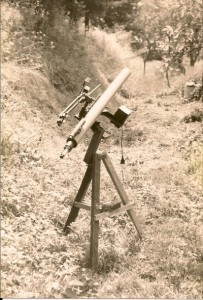Sergio Bertolucci, Director for Research at CERN, comes to ESO to talk about LHC

X-Shooter goes on sky – 5th episode
January 21, 2009
CERN’s Director for Science at ESO: an outlook of LHC
May 11, 2009When I was ten or so, I was already a science enthusiast, even though I certainly did not know what science actually meant (to be honest I cannot say I fully understand it even now). But I remember I was playing with old shoes boxes, connecting them with wires and piercing them with screws. Using a pencil I drew meters, buttons and cursors on them, pretending they were sophisticated equipment. I would say they represented the start of my scientific career, which then went through several interesting stages. Included those explosions I produced trying to distill petrol. Or when I injected a spark into a pipe full of hydrogen produced by water electrolysis (much to my grandmother’s dismay. She was almost deaf, but she could hear them rather well).
I am sure many of my colleagues had very similar experiences, which contributed one way or another, to the way they look at nature today.
One of the myths populating the fantasies of my young mind in those times (but I am sure this part of the background of any scientist dealing with physics), was definitely CERN. Founded in 1954, this international organization has been leading particle physics research ever since. Many of you might remember the successes of the Large Electron Proton Collider (LEP) at the time when Carlo Rubbia and Simon van der Meer won the Nobel Prize (1984). Among other things, even the WEB was invented at CERN.
When the European Southern Observatory (the organization I work for) was created, back in 1962, it actually had its headquarters at CERN. In a sense, in Europe ESO represents for experimental astronomers what CERN is for particle physicists. A term of reference, an entity with which you will be, sooner or later, interacting with. I some cases (as in mine) you will be part of it in the course of your career.
The two organizations work at the two extremes of the same problem: CERN aiming at the infinitely small, ESO at the infinitely large. So, even though separated by many tens of orders of magnitudes, they are intimately related.
This is why, some time ago, I thought about inviting somebody from CERN here at ESO, to give us an overview on the status of the Large Hadron Collider (LHC), its perspectives and the impact it will have on our understanding of the Universe. As you know, more and more exotic beasts are making their appearance in an already well populated zoo. Even though we talk about Dark Matter and Dark Energy as if they were every day’s stuff, we do not have a clue of what they could be. Most likely the answer will come from high energy experiments, like the LHC.
Together with Carlos de Breuck I am organizing seminars and colloquia here at ESO. So, using the privileges I have being in this position, I just wrote an email to CERN (while I was doing it I still could not believe all of this was really happening). And it worked. The day after Arnaud Marsollier, the European Astroparticle Physics Network outreach coordinator, answered back very positively, telling me that they were looking for someone who could satisfy our request, which was to give an astrophysically-oriented presentation on the LHC.
You cannot figure our my surprise when he wrote back, some weeks after, telling me that Prof. Sergio Bertolucci, Director for Research and Scientific Computing at CERN, would come to ESO.
A former Pisa scholar, Sergio Bertolucci has worked at DESY, Fermilab and Frascati. He was a member of the group that founded Fermilab’s CDF experiment and has been involved in the design, construction and running of the CDF detector. Before taking over the Directorate for Research at CERN, Bertolucci was already chairing the LHC committee and was a member of DESY’s physics research committee. He was also vice-president and a member of the Board of the Italian National Institute of Nuclear Physics (INFN).
All of this was happening not very much after the LHC First Beam. You might remember that there was quite a bit of noise about the LHC producing doomsday phenomena, like mini black-holes that would eat our planet. Just by a coincidence, I was reading a nice science fiction novel by Craig Wheeler, The Krone Experiment, when the first beam was produced.
Craig Wheeler, professor of Astronomy at the University of Texas at Austin, had written this novel (now also a movie) back in 1994, but I had never had the chance to read it before the end of 2008. I was in the process of writing a paper on a nearby Supernova observed with the Very Large Telescope, and Craig happened to be one of the collaborators (well, actually he is one of the minds of the whole project and one of the world experts in the SN field…). So, I thought it was a good idea and the right time to read his novel.
And it was even more timely, because it coincided with the LHC first beam and all the ado [for nothing] this has created (or better revived. Catastrophic announcements started in 2003). Funny enough, the Krone Experiment is about a very similar accident that, in the fiction, happened to Dr Krone, who creates a black hole that starts to orbit around the Earth’s center and, during its journey, it eats up the planet. If you like the gender, just read Craig’s book. You’ll enjoy it.
Sometimes chance creates very strange coincidences. This was certainly one of them.
Next week Sergio Bertolucci is going to be here and I am sure it will be an extremely interesting experience. If you happen to be around, join us in the ESO Auditorium on Tuesday May 5th, 15:00. I might be posting something more about this event. Check next week.
When I was messing around with those boxes, wires and explosive stuff I would have never imagined that one day I would have become a real scientist (whatever that means). Let alone having one of the leaders of the LHC experiment giving a talk at my institute. Sometimes dreams become reality…



